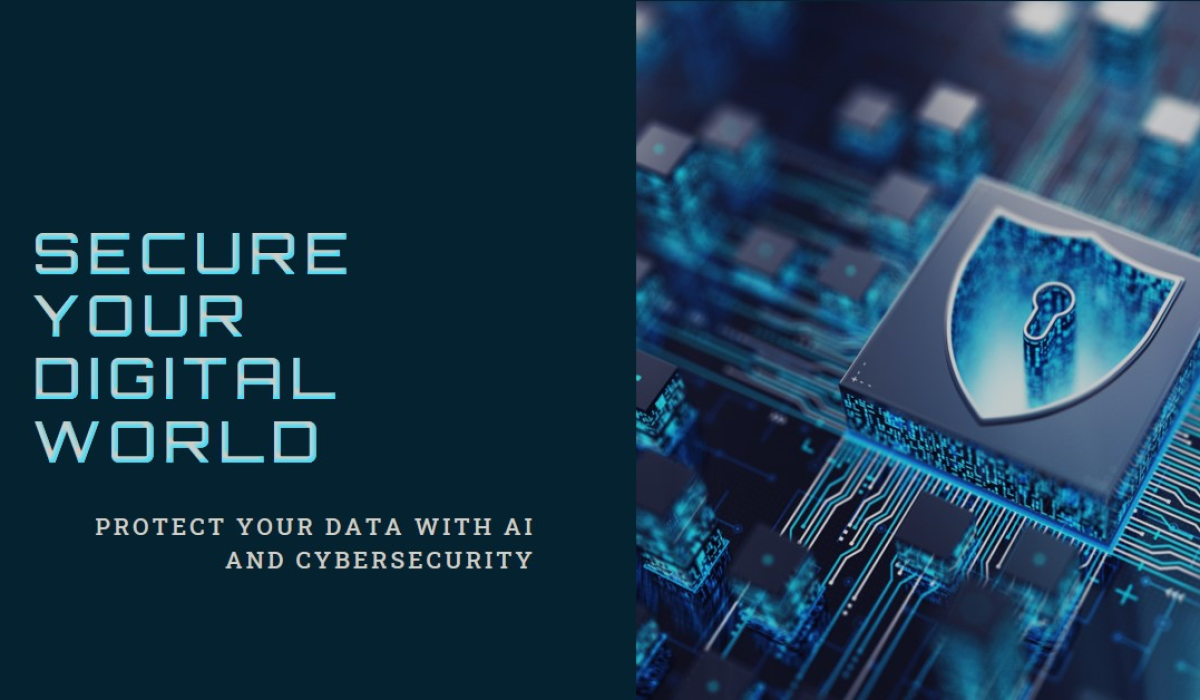In today’s digital world, cybersecurity is more critical than ever. As we rely on technology for everything from banking to healthcare, the potential consequences of cyberattacks are immense. These attacks can steal personal information, disrupt critical infrastructure, and even cause physical harm.
The Growing Threat Landscape
Unfortunately, cyber threats are becoming increasingly sophisticated. Hackers are constantly developing new techniques to exploit vulnerabilities in systems and networks. This means that traditional security measures are no longer enough. We need new tools and approaches to stay ahead of the curve.
This is where Artificial Intelligence (AI) comes in. AI has the potential to revolutionize cybersecurity by automating tasks, identifying threats faster, and even predicting future attacks.
1.The Role of AI in Detecting Cyber Threats
1.1: AI Techniques for Threat Detection
The ever-evolving threat landscape demands powerful tools for detection. AI offers a robust set of techniques to identify and combat cyber threats:
- Machine Learning (ML): ML algorithms analyze vast amounts of data (network traffic, user behavior, etc.) to identify patterns and anomalies that might indicate malicious activity. These algorithms can learn and adapt over time, improving their ability to detect new threats. For instance, an ML model can analyze email patterns to identify phishing attempts based on language, sender information, and attachment types.
- Deep Learning (DL): A subfield of ML, DL uses artificial neural networks to mimic the human brain’s structure and function. DL excels at processing complex data like network traffic or malware code, allowing for highly accurate threat detection. Deep learning models can identify subtle variations in malware behavior, even if attackers attempt to disguise their code.
- Anomaly Detection: This technique focuses on identifying deviations from normal user behavior or network activity. By establishing a baseline of “normal” activity, AI can flag any significant deviations that might indicate a potential attack. For example, a sudden spike in login attempts from an unusual location could trigger an anomaly alert.
- Pattern Recognition: AI excels at recognizing patterns in data. Security professionals can leverage this ability to identify known attack signatures and malicious code within network traffic. Pattern recognition allows AI systems to detect known threats quickly and efficiently.
- Predictive Analytics: AI can analyze historical data and threat intelligence to predict future attacks. By identifying trends and attacker behavior patterns, security teams can proactively take steps to mitigate potential threats before they occur.
1.2: Real-time Monitoring and Response
The traditional, reactive approach to cybersecurity is no longer sufficient. AI enables real-time monitoring and response, providing a significant advantage:
- Continuous Threat Monitoring: AI systems can continuously monitor network activity, user behavior, and system logs for suspicious activity. This allows for immediate detection of threats, minimizing potential damage.
- Automated Threat Response: AI-powered security solutions can automate some aspects of threat response, such as isolating infected devices, blocking malicious traffic, and notifying IT security teams. This reduces the burden on security personnel and allows for faster response times.
- AI-driven Security Solutions: Several AI-powered security solutions are available today:
- Security Information and Event Management (SIEM) systems leverage AI to analyze logs from various security tools, identify potential threats, and prioritize alerts for security teams.
- Endpoint Detection and Response (EDR) solutions utilize AI to monitor individual devices for malware, suspicious behavior, and unauthorized access attempts.
- User and Entity Behavior Analytics (UEBA) systems employ AI to analyze user activity and identify potential insider threats or compromised accounts.
1.3: Case Studies of AI in Cybersecurity
Here are some examples of successful AI implementations in cybersecurity:
- Financial Institution Prevents Fraud: A large bank used AI to analyze customer transactions in real-time. The AI identified a fraudulent scheme attempting to steal millions of dollars by detecting unusual spending patterns on stolen credit cards.
- Healthcare Provider Thwarts Ransomware Attack: A hospital deployed AI to monitor network traffic. The AI system detected a ransomware attack in its early stages, allowing the hospital to isolate infected systems and prevent the attack from spreading.
- Retail Giant Blocks Data Breach: A retail company implemented AI-powered anomaly detection on its customer database. The AI identified suspicious access attempts and blocked a data breach attempt before any customer information was compromised.
2.The Role of AI in Preventing Cyber Threats
While AI excels at threat detection, its true power lies in preventing attacks altogether. Here’s how AI is transforming preventative cybersecurity:
2.1: Proactive Threat Hunting
Traditionally, cybersecurity focused on reactive measures – waiting for attacks to happen and then responding. Proactive threat hunting flips this script. It involves actively searching for threats within a network, identifying potential vulnerabilities, and taking steps to mitigate them before they can be exploited.
AI significantly enhances proactive threat hunting capabilities:
- Automated Threat Analysis: AI can analyze vast amounts of security data (logs, network traffic) to identify subtle indicators of compromise (IOCs) that might be missed by human analysts. This allows for earlier detection of potential threats.
- Threat Behavior Modeling: AI can learn from historical attack data and threat intelligence to develop models of attacker behavior. These models can then be used to identify suspicious activity that might indicate an impending attack.
- Prioritization and Alert Fatigue Reduction: Security teams are often overwhelmed with security alerts. AI can prioritize alerts based on severity and context, allowing security personnel to focus on the most critical threats.
2.2: Automated Security Protocols
Human error is a significant factor in many cyberattacks. AI can automate various security protocols, reducing human error and improving overall security posture:
- Automated Patch Management: AI can streamline patch management by identifying vulnerable systems, prioritizing patches based on risk, and even automating the patching process. This ensures systems are kept up-to-date with the latest security fixes.
- Automated Incident Response: For certain types of attacks, AI can automate pre-defined response actions. This could involve isolating infected devices, blocking malicious traffic, or initiating remediation procedures. Automating these tasks frees up security personnel to handle more complex incidents.
- Identity and Access Management (IAM): AI can analyze user behavior and access patterns to identify suspicious activity. This can help prevent unauthorized access attempts and insider threats.
2.3: Predictive Maintenance and Vulnerability Management
Predictive maintenance involves using data analysis to anticipate potential equipment failures before they occur. AI can be applied in a similar way for cybersecurity:
- Vulnerability Scanning and Prioritization: AI can analyze network configurations and software to identify potential vulnerabilities. By prioritizing vulnerabilities based on exploitability and risk, security teams can focus on patching the most critical ones first.
- Security Posture Optimization: AI can continuously monitor security controls and configurations, identifying weaknesses and recommending improvements. This helps organizations maintain a strong security posture and minimize their attack surface.
- Threat Intelligence Integration: AI can integrate with threat intelligence feeds to stay updated on the latest vulnerabilities and attack methods. This allows for proactive mitigation strategies before attackers can exploit these vulnerabilities.
3.Challenges of Securing AI Systems Against Attacks
While AI offers immense potential for cybersecurity, it’s not without its challenges. Here are some key areas where securing AI systems requires careful attention:
3.1: Adversarial Attacks on AI Models
Adversarial attacks are deliberate attempts to manipulate AI models into making wrong decisions. Attackers can achieve this by feeding the model with specially crafted inputs – adversarial examples. These examples may be imperceptible to humans but can cause the AI to misclassify an object, overlook a threat, or even perform a harmful action.
The impact of adversarial attacks on AI for cybersecurity can be significant:
- Compromised Intrusion Detection Systems (IDS): An attacker could craft adversarial network traffic that bypasses an AI-powered IDS, allowing them to gain access to a network undetected.
- Bypassed Spam Filters: Adversarial emails could trick AI spam filters, allowing phishing attempts to reach inboxes.
- Manipulated Malware Detection: Malicious actors could modify malware code to evade detection by AI-based antivirus software.
These examples highlight the importance of developing robust AI models resistant to adversarial attacks.
3.2: Data Poisoning and Model Integrity
The effectiveness of any AI model hinges on the quality of its training data. Data poisoning is a malicious attempt to manipulate an AI model’s training data with the goal of influencing its behavior. Attackers can inject false or biased data into the training dataset, causing the model to learn incorrect patterns and make inaccurate predictions.
Here’s how to secure training data and model integrity:
- Data provenance and validation: Ensuring data comes from trusted sources and implementing robust data validation techniques can help mitigate the risk of poisoned data.
- Data monitoring and anomaly detection: Continuously monitoring training data for anomalies and suspicious changes can help identify potential poisoning attempts.
- Model interpretability and explainability: Developing AI models that are interpretable and explainable allows security teams to understand how the model arrives at its decisions and identify potential biases or vulnerabilities.
3.3: Ensuring Privacy and Compliance
The use of AI in cybersecurity raises several privacy concerns and compliance issues:
- Data Privacy: AI systems for cybersecurity often rely on vast amounts of data, including user activity logs and network traffic. Ensuring this data is collected, stored, and used in accordance with privacy regulations is crucial.
- Algorithmic Bias: AI models can perpetuate biases present in the training data. Biased AI models in cybersecurity could lead to unfair or discriminatory actions, such as unfairly flagging certain user activities as suspicious.
- Compliance with Regulations: Regulations like GDPR (General Data Protection Regulation) and HIPAA (Health Insurance Portability and Accountability Act) impose restrictions on data collection and usage. Organizations using AI for cybersecurity need to ensure compliance with these regulations.
Recap: AI’s Role in Cybersecurity
Artificial intelligence is revolutionizing cybersecurity by:
- Enhancing Threat Detection: AI excels at analyzing vast amounts of data to identify threats in real-time, including malware, phishing attempts, and suspicious user behavior.
- Proactive Threat Prevention: AI facilitates proactive threat hunting and vulnerability management, enabling organizations to identify and address weaknesses before attackers can exploit them.
- Automating Security Tasks: AI automates security protocols, such as patch management and incident response, freeing up security personnel to focus on more complex tasks and reducing human error.
Challenges and the Road Ahead
While AI offers immense potential, securing AI systems themselves presents challenges:
- Adversarial attacks can manipulate AI models, highlighting the need for robust AI development practices.
- Data poisoning threatens model integrity, requiring measures to ensure data quality and model interpretability.
- Privacy concerns and compliance issues necessitate responsible data collection and adherence to regulations.
Stay Informed, Stay Secure
The field of AI in cybersecurity is rapidly evolving. By staying updated on advancements in AI and best practices for securing AI systems, organizations can leverage this powerful technology to create a more secure digital future.





